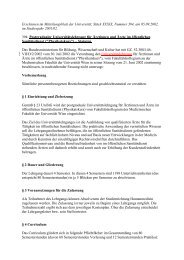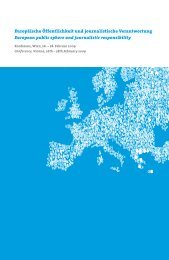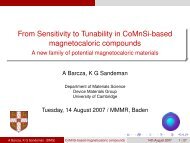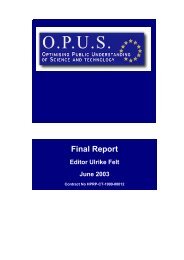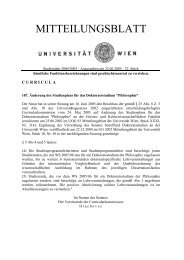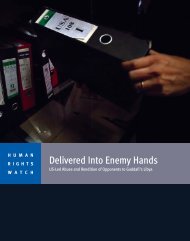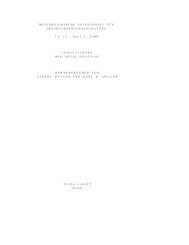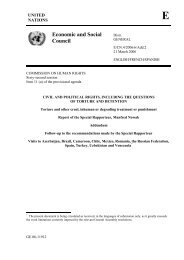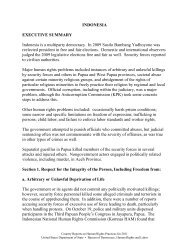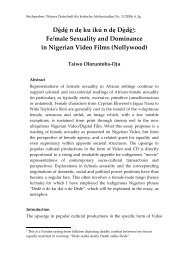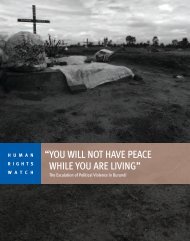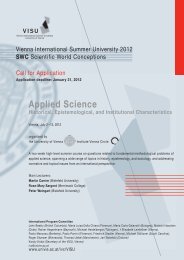(Stand: 25. Juli 2007) ANDERSON, Michael Alan ... - Universität Wien
(Stand: 25. Juli 2007) ANDERSON, Michael Alan ... - Universität Wien
(Stand: 25. Juli 2007) ANDERSON, Michael Alan ... - Universität Wien
You also want an ePaper? Increase the reach of your titles
YUMPU automatically turns print PDFs into web optimized ePapers that Google loves.
MEDIEVAL & RENAISSANCE MUSIC CONFERENCE <strong>2007</strong> – WIEN, 7.-11. AUGUST ABSTRACTS<br />
RYGG, Kristin (Department of Musicology, Hedmark University College)<br />
Music as Ritual and Ritual Music<br />
Samstag/Saturday, 11.8., 9.15 Uhr, KuGe, SR 1<br />
In my understanding the English court masque of the late Renaissance stands out as a music<br />
theatre offering an ultimate realization of esoteric Renaissance ideals, focusing on the<br />
interplay of the arts as a path to spiritual development.<br />
The masques were evidently suffused by singing, music and dance, but the bulk of<br />
the musical sources are lost, and those remaining can only render a fragmented impression<br />
of the musical side of these shows. Previous musicological studies have to a large degree<br />
focused on various aspects of classification and attribution projects, whereas masque<br />
scholarship at large has shown little interest in the music of the masques.<br />
The paper I propose is a further development from my book Masqued Mysteries Unmasked<br />
(Pendragon 2000). Using intermedial strategies combined with an approach inspired<br />
by recent musical hermeneutics I shall argue that the makers of the Jonsonian<br />
masque (created by poet laureate Ben Jonson in collaboration with prominent composers,<br />
dancing masters and architect Inigo Jones) understood the masque as a ritual where the<br />
interplay of music, poetry and dance IS the core of the rite; where this very interplay constitutes<br />
the active vehicles of transcendence in the celebration of the rite. Through the<br />
interpretation of music from the earlier stage of the Jonsonian masque I intend to demonstrate<br />
that the leading creators of the masque were aiming at making music that in particular<br />
ways could serve as a vehicle of transcendence in this ritual.<br />
I shall conclude my paper with an interpretation of music from one of the last Renaissance<br />
masques (text by William D’Avenant and music by William Lawes). Here we<br />
can see how the concept of the masque as ritual has been consolidated, and how the concept<br />
of music as ritual has developed into a musical style which may be understood as an<br />
expression of the concept of ritual music.<br />
� �<br />
SAUNDERS, Zoe (University of Maryland)<br />
The Anonymous Missa Cueur langoreulx and its Model<br />
Mittwoch/Wednesday, 8.8., 12.15 Uhr, MuWi, HS 1<br />
Among the 22 anonymous masses contained in the so-called Alamire manuscripts is an<br />
unedited canonic, five-voice imitation mass – the Missa Cueur langoreulx – unique to<br />
Montserrat 766 (a manuscript thought to have been sent to Charles V in Spain). I identify,<br />
for the first time, the model for this mass as a chanson by Josquin des Prez and examine<br />
the relationship between the mass and its model from an analytical perspective. In<br />
order to determine the composer’s working methods and to place this mass in the context<br />
of the 16 th -century polyphonic tradition, I will examine the anonymous composer’s treatment<br />
of his borrowed material, the modal, mensural, and thematic structure of the mass in<br />
comparison to that of the chanson, and, on a smaller scale, motivic development and internal<br />
cadences. An investigation into why the anonymous composer may have chosen<br />
this song as a cantus firmus and his treatment of his polyphonic model, the reception of<br />
- 66 -




